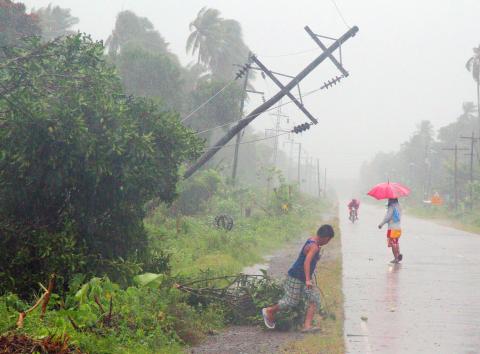The strongest typhoon to hit the Philippines this year pounded the southern island of Mindanao yesterday and about 40 people were dead or missing after the storm destroyed homes and brought down power and communications lines, reports said.
Typhoon Bopha, with wind gusts of up to 195kph, made landfall at dawn, uprooting trees and tearing off roofs.
About 40 people were killed or missing in flash floods and landslides near a mining area on Mindanao, ABS-CBN television reported, saying water and soil had swept through an army post.

Photo: AFP
A television reporter said she saw numerous bodies lined up near the army base. A military spokesman earlier said about 20 people, including six soldiers, were missing.
Disaster official Liza Mazo said more casualties were expected to be discovered as search and rescue teams fanned out.
Media said dozens of people were injured by flying debris and falling trees, and swept away by swollen rivers and flash floods, but the relatively low death toll was due in part to an early evacuation. More than 155,000 people were in shelters when the typhoon hit.
About 20 typhoons hit the nation each year, often causing death and destruction. Typhoon Washi killed 1,500 on Mindanao last year.
“We have suffered enough,” Felicitas Cabusao said, clutching a Holy Rosary beside her crying 12-year-old daughter.
Cabusao said her daughter survived Typhoon Washi, almost exactly a year ago, after she was washed out to sea when flash floods swept away entire coastal villages.
Dozens of domestic flights and ferry services in the central and southern Philippines were suspended. Schools and some businesses were closed.
Typhoon Bopha was heading west-northwest and was expected to move out into the South China Sea by tomorrow.

Tropical Storm Usagi strengthened to a typhoon yesterday morning and remains on track to brush past southeastern Taiwan from tomorrow to Sunday, the Central Weather Administration (CWA) said yesterday. As of 2pm yesterday, the storm was approximately 950km east-southeast of Oluanpi (鵝鑾鼻), Taiwan proper’s southernmost point, the CWA said. It is expected to enter the Bashi Channel and then turn north, moving into waters southeast of Taiwan, it said. The agency said it could issue a sea warning in the early hours of today and a land warning in the afternoon. As of 2pm yesterday, the storm was moving at

DISCONTENT: The CCP finds positive content about the lives of the Chinese living in Taiwan threatening, as such video could upset people in China, an expert said Chinese spouses of Taiwanese who make videos about their lives in Taiwan have been facing online threats from people in China, a source said yesterday. Some young Chinese spouses of Taiwanese make videos about their lives in Taiwan, often speaking favorably about their living conditions in the nation compared with those in China, the source said. However, the videos have caught the attention of Chinese officials, causing the spouses to come under attack by Beijing’s cyberarmy, they said. “People have been messing with the YouTube channels of these Chinese spouses and have been harassing their family members back in China,”

The Central Weather Administration (CWA) yesterday said there are four weather systems in the western Pacific, with one likely to strengthen into a tropical storm and pose a threat to Taiwan. The nascent tropical storm would be named Usagi and would be the fourth storm in the western Pacific at the moment, along with Typhoon Yinxing and tropical storms Toraji and Manyi, the CWA said. It would be the first time that four tropical cyclones exist simultaneously in November, it added. Records from the meteorology agency showed that three tropical cyclones existed concurrently in January in 1968, 1991 and 1992.

GEOPOLITICAL CONCERNS: Foreign companies such as Nissan, Volkswagen and Konica Minolta have pulled back their operations in China this year Foreign companies pulled more money from China last quarter, a sign that some investors are still pessimistic even as Beijing rolls out stimulus measures aimed at stabilizing growth. China’s direct investment liabilities in its balance of payments dropped US$8.1 billion in the third quarter, data released by the Chinese State Administration of Foreign Exchange showed on Friday. The gauge, which measures foreign direct investment (FDI) in China, was down almost US$13 billion for the first nine months of the year. Foreign investment into China has slumped in the past three years after hitting a record in 2021, a casualty of geopolitical tensions,